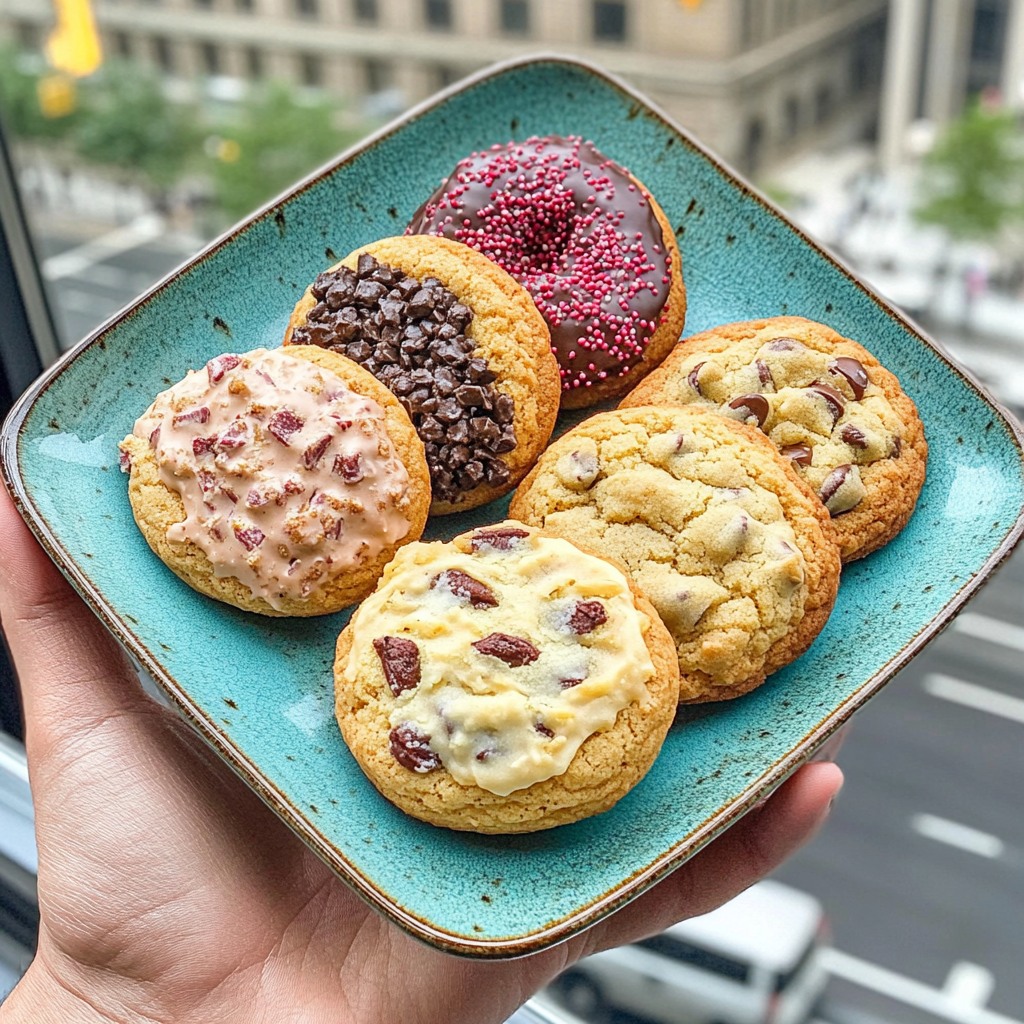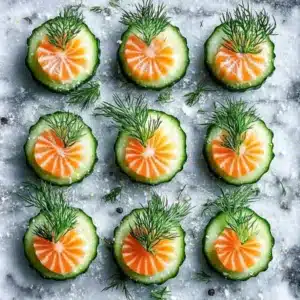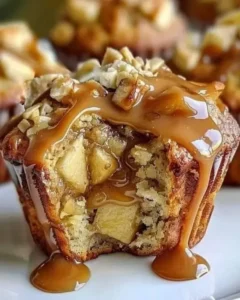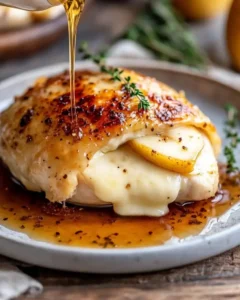Stuffed Cookies Sampler: A Sweet Delight Experience
Imagine biting into a cookie so delicious that it transports you to a world of sweet bliss. That’s exactly what you’ll experience with our Stuffed Cookies Sampler by Firecakes Donuts. These delectable cookies, filled with a surprise center, offer a burst of rich, gooey goodness with every bite. Enjoy the perfect harmony of flavors and textures that make these stuffed cookies an absolute delight for dessert lovers.
The Stuffed Cookies Sampler brings together the best of Firecakes Donuts’ creativity and passion for baking. Perfect for gatherings, celebrations, or simply indulging in a treat, these cookies impress with their irresistible filling and tender exterior. With each cookie, uncover a different surprise, making every bite an exciting adventure. The combination of specially selected ingredients and an expert preparation process results in cookies that are as delightful to look at as they are to taste.
Quick Recipe Highlights
- Flavor Profile: The Stuffed Cookies offer a sweet and rich taste that is balanced with a touch of saltiness. The filling, whether chocolate, caramel, or fruit-based, elevates the overall flavor experience.
- Texture: Each cookie boasts a soft, chewy exterior with a satisfyingly gooey center, offering a contrast that excites the palate.
- Aroma: The warm, inviting scent of freshly baked cookies combined with hints of vanilla and a subtle caramel undertone makes these cookies hard to resist.
- Visual Appeal: With their perfectly golden-brown exterior and visually appealing fillings, these cookies are a treat for the eyes as well as the taste buds.
- Skill Level Needed: While intermediate baking skills are required, the detailed instructions make these cookies accessible for enthusiastic home bakers eager to expand their repertoire.
- Special Equipment: A cookie scoop and parchment-lined baking sheets are essential to achieve evenly sized cookies and a perfect bake.
Recipe Overview
- Difficulty Level: Intermediate – The recipe involves techniques like making the cookie dough, stuffing, and proper baking, which require some experience for flawless execution.
- Category: Desserts – These stuffed cookies are best enjoyed as a sweet finale to any meal or as a special treat to satisfy sweet cravings.
- Cuisine: American – These cookies are reminiscent of classic American-style cookies with a creative twist of surprise fillings.
- Cost: Moderate – High-quality ingredients, especially for varied fillings, might add up, but the enjoyment and satisfaction they provide are priceless.
- Season: All seasons – Stuffed Cookies are a year-round delight, perfect for every occasion, whether it’s a summer picnic or a cozy winter gathering.
- Occasion: Ideal for birthday parties, holiday celebrations, and when you simply want to share a homemade sweet treat with friends and family.
Why You’ll Love This Recipe
The Stuffed Cookies Sampler promises an indulgent experience that excites both taste and texture desires. These cookies stand out with their delightful contrast of a slightly crisp exterior and a luscious, molten center in every bite. They provide not just taste satisfaction, but also a textural delight that will captivate cookie lovers. Perfect for anyone who appreciates layers of flavor, these cookies never fail to impress.
Convenience is another notable benefit of this recipe. Despite the rewarding outcome, the preparation is straightforward and manageable with clear step-by-step guidance, making it a great choice for bakers of varying skill levels. From gathering the straightforward ingredients to savoring the final product, the process is enjoyable and rewarding.
There is also a nutritional advantage to making your stuffed cookies at home. By selecting quality ingredients and adjusting the filling to personal preferences, you can control the sugar content and even accommodate dietary needs. Whether choosing dark chocolate for antioxidants or adding nuts for healthy fats, there are nutritional choices to be made for more health-conscious bakers.
Socially, the Stuffed Cookies Sampler makes for an excellent conversation starter at events. Each cookie offers a different surprise filling, prompting delightful reactions and interaction among your guests. Sharing these homemade treats is a way to showcase personal baking skills and bring joy through delicious foods.
Finally, these cookies are cost-effective in terms of the pleasure they deliver, using readily available ingredients that won’t break the bank. With the option to customize the fillings based on what’s on hand, these cookies remain affordable and flexible, ensuring they’re perfect for any budget-conscious baker looking to make a big impression.
Historical Background and Cultural Significance
The idea of stuffed cookies, mixing mediums like dough and fillings, traces its origins to diverse global baking traditions. Such confections have long been part of bakeries around the world, each culture incorporating its unique tastes and ingredients into the mix. American cuisine adopted and innovated, making stuffed cookies a part of the dessert evolution.
Cultural significance lies in the communal aspect of baking cookies. Often a family or community event, it’s a restatement of togetherness and shared joy, bringing people together over the anticipation and enjoyment of fresh, homemade treats. Stuffed cookies fit perfectly within this tradition, offering a spectrum of flavors that cater to diverse tastes within social settings.
Over time, the recipe for stuffed cookies has evolved. Initially, simple fillings were used, but as culinary techniques advanced, more creative options, like various chocolates, caramels, and fruit compotes, came into play. Today, home and professional bakers alike experiment with an array of fillings to continuously recreate and personalize this beloved recipe.
There are no strict regional variations in America for stuffed cookies, but across different communities, you’ll find favorite flavors and presentations reshaped by personal and regional tastes. Some prefer adding a pinch of local spices, while others might use seasonal fruits or opt for flavor profiles that remind them of home, ensuring variations remain limitless.
Ingredient Deep Dive
For these stuffed cookies, the choice of flour is crucial. All-purpose flour provides a balanced texture, creating a sturdy surface to encase each cookie’s delightful center. Historically, all-purpose flour has been the go-to due to its versatility, providing just the right balance of gluten. It allows the cookies to rise properly while maintaining a tender bite. For storage, keep all-purpose flour in an airtight container in a cool, dry place to prevent rancidity and moisture absorption.
Sugar acts both as a sweetener and as a tenderizer. Granulated sugar yields a crisp edge, while brown sugar, with its molasses content, keeps the centers moist and adds depth of flavor. The choice of a combination of sugars is rooted in traditional methods, ensuring a balance of sweetness and moisture. For using alternatives, coconut or date sugar can substitute in part for a healthier twist, though it may alter the caramel notes achieved through brown sugar.
The filling options are where creativity shines. Conventional choices include chocolate chunks, caramel bits, or preserves. Chocolate, often preferred due to its ability to melt just right within the dough, originates from centuries-old traditions of adding luxury and depth to baked goods. Dense and flavorful, your filling should complement the dough, not overpower it. Customize fillings to suit taste and dietary requirements – nuts, dried fruits, or even creams offer variations that meet various needs and preferences.
Common Mistakes to Avoid
- Overmixing the dough can lead to tough cookies. Stir until just combined to maintain tenderness.
- Failing to chill the dough before shaping can cause cookies to spread unevenly during baking.
- Underbaking is common; cookies should appear set and slightly golden on the edges when done.
- Not fully sealing the edges after filling may cause leakage during baking, losing the luscious center.
- Using fillings with high water content can make cookies soggy. Opt for denser fillings instead.
- Skipping the parchment lining on baking sheets can result in sticky cookies that break when removed.
- Opening the oven too often disrupts the baking environment, leading to uneven cooking.
- Ignoring proper cooling on racks can make cookies continue to cook, resulting in hardness.
- Improperly storing in unsealed containers can lead to stale or hard cookies over time.
- Not preheating the oven to the correct temperature can prevent proper rising and texture.
Essential Techniques
Mastering the stuffing technique is vital for these cookies. It involves wrapping the dough completely around the filling, ensuring no exposure. This step guarantees the filling won’t spill out during baking and the cookie maintains its shape. To achieve this, gently cradle the dough in your hand, place the filling in the center, and carefully draw up the sides of the dough around it, pinching seams to seal thoroughly.
Chilling the dough is a crucial technique often overlooked. By allowing the cookie dough to chill, the fats within the dough firm up, giving cookies structure and preventing excessive spread during baking. Chill the dough for at least 20 minutes before baking; longer if time permits. Proper chilling also enhances flavor development and improves the cookie’s final texture.
Recognizing visual cues during baking helps to avoid under or overbaked cookies. Look for subtle signs: edges turning golden and centers losing their sheen are indicators of doneness. Understanding these visual markers instead of relying solely on time can dramatically improve your baking outcome. Every oven bakes differently, so always keep an eye on your cookies for personalized perfection.
Pro Tips for Perfect Stuffed Cookies Sampler
For uniform cookies, use a cookie scoop to portion dough effectively, ensuring consistent size and even cooking. By doing so, you achieve predictability in results, allowing for a visually appealing and uniformly baked batch.
Experiment with fillings to personalize your sampler. Consider unique flavor combinations such as dark chocolate with sea salt or spiced apple compote for a seasonal twist. This not only elevates the recipe but adds your signature touch to each cookie.
Ensure ingredients, especially butter and eggs, are at room temperature before mixing. This allows for even blending, contributing to texture and flavor enhancement.
Incorporate mix-ins like chopped nuts or small chocolate chips directly in the dough for added surprises. These added elements increase complexity without altering the basic structure of the cookie.
Always rest cookies on a cooling rack after baking. This prevents cookies from continuing to bake on hot pans and ensures a crispier finish on the outside.
Remember, practice makes perfect. Don’t be afraid to make multiple batches to refine your technique and find your personal favorite balance of dough and filling.
Variations and Adaptations
Regional variations might include using local ingredients unique to particular areas—think citrus zest in warmer regions or maple-flavored fillings in colder climates. These adapt the base recipe to local tastes, emphasizing regional uniqueness.
Seasonal adaptations naturally occur with ingredient availability. Try pumpkin spice filling in the fall or a fresh strawberry jam center in the spring for a refreshing and timely adaptation to the classic recipe.
Dietary modifications are possible with careful substitutions. Almond or oat flour can replace all-purpose flour for gluten-free versions, while coconut oil might substitute butter for a dairy-free option. Customize to meet dietary needs without sacrificing too much of the core integrity of the cookie.
Flavor variations can be as simple as changing extracts in the dough from vanilla to almond or experimenting with new spice blends. This not only adds intrigue but also personalizes each batch with little effort.
For those desiring a textural change, consider adding oatmeal to the dough for a chewier cookie. Alternatively, integrate rice cereal for added crunch, playing with contrast for an exciting mouthfeel.
In presenting your cookies, varying shapes might make these cookies more playful. Instead of traditional rounds, try shaping them in squares or hearts for themed events, bringing joy beyond flavor into the visual realm.
Serving and Presentation Guide
For an inviting presentation, stack the cookies in a pyramid form on a platter, interspersed with colorful fruits for an eye-catching contrast of colors. This method of presentation is not only visually appealing but also invites a communal grab-and-go style suitable for casual settings.
Garnishing ideas include dusting the cookies lightly with powdered sugar or drizzling with a complementary sauce or melted chocolate for visual and flavor enhancement. This extra touch adds elegance and can be tailored to harmonize with the cookie’s filling.
Pair these cookies with traditional accompaniments like a glass of cold milk or a scoop of vanilla ice cream for a classic touch. The combination enhances the experience by playing hot against cold, chewy against creamy textures.
Modern serving suggestions might see these cookies plated individually with a rich sauce or coulis beneath each cookie, dressed with edible flowers for a contemporary twist that appeals to the modern aesthetic.
Always consider temperature when serving; these cookies are best enjoyed slightly warm when the filling is at its smoothest and most luxurious consistency. Reheat briefly if serving after a prolonged period.
For portion control, consider serving in a bento-style box with individual compartments for each cookie. This method is visually tidy and ensures each guest receives a pre-determined amount, ideal for mindful indulgence.
Wine and Beverage Pairing
For a wine pairing, consider a sweet wine such as a late harvest Riesling or a Port. The natural sweetness of these wines complements and highlights the rich flavors of the cookie fillings without overpowering them, providing a harmonious pairing.
Non-alcoholic alternatives could include a spiced chai or a rich, creamy hot chocolate. These beverages offer warmth and flavor that plays well with the stuffed cookies, creating a comforting and satisfying pairing perfect for non-drinkers or younger guests.
If coffee is your beverage of choice, pair these cookies with a bold espresso or a cinnamon-infused latte. The robust flavor of coffee can contrast beautifully with the sweetness of the cookies, complementing their rich notes.
Temperature considerations for pairings are critical—serve beverages slightly warmer in colder months to add coziness and fresh, chilled options in warmer weather for a refreshing touch.
For formal occasions, consider serving a degustation set of cookies paired with miniature glasses of complementing beverages. This sophisticated approach allows guests to savor each mini pairing, offering a curated tasting experience.
Storage and Shelf Life
Store stuffed cookies in airtight containers at room temperature to maintain freshness for 4-5 days. This method prevents moisture loss, ensuring cookies stay soft and delectable longer.
Cool the cookies completely before storing to prevent condensation, which can lead to a soggy texture. Separation of layers with parchment paper is recommended if stacking to avoid sticking.
Look for signs of spoilage such as mold, off-smells, or changes in appearance, especially if cookies are stored for extended periods.
To reheat, place cookies in a preheated oven at 350°F for a few minutes or microwave briefly until warm. This quick refreshment helps revive the filling’s gooey texture.
If freezing, individually wrapping cookies in plastic and placing them in a zip lock bag preserves them for up to two months with minimal flavor and texture compromise. This also allows for the convenience of defrosting single servings as needed.
Make Ahead Strategies
The dough for stuffed cookies can be made ahead and chilled for up to 48 hours, allowing flavors to develop deeper. Store in an airtight container or tightly wrapped to prevent refrigerator odors from affecting the dough.
Between steps, store dough at recommended chilled temperatures. It’s essential for maintaining structure and ease during filling processes.
Make the fillings ahead and store them separately. Storing them in individual portions can streamline assembly, especially useful for multi-flavor batches, saving time and ensuring consistency.
If preparing for hosting, bake cookies fresh just before serving, but have the dough ready ahead to lessen day-of tasks. They can also be partially baked, frozen, and finished cooking on the event day for fresh, warm presentation.
Reheated cookies should retain their freshness, especially if warmed slightly before serving. This small step restores a homemade feel and warmth.
Fresh-element additions like last-minute glazes can be made in advance but put on hold until just before presentation to maintain appearance and texture integrity.
Scaling Instructions
Halving the Stuffed Cookies Sampler recipe involves dividing ingredient quantities evenly while ensuring proportions remain consistent. Adjust equipment size accordingly, from smaller mixers to more compact baking sheets, to prevent uneven baking.
For doubling or tripling the recipe, consider the capacity of your appliances and kitchen tools. Larger batches might require multiple baking sheets or sessions to accommodate, ensuring even cooking across more significant volumes.
Timing should be adjusted based on the number of cookies being baked simultaneously; more cookies mean longer baking time and cooling down before storing, especially if using a conventional oven.
Storage considerations play an even more critical role when scaling. Make sufficient space and plan packaging strategies to optimize freshness and avoid overcrowding containers.
For larger baking projects, organize a prep line for efficiency. Sequence tasks such as dough preparation, chilling, filling, and baking to streamline operations and ensure smooth scaling-up processes.
Nutritional Deep Dive
The Stuffed Cookies Sampler contains a balance of macronutrients; primary ingredients, such as flour and sugars, contribute carbohydrates, while butter and fillings introduce fats. The protein content is modest, typically from flour and any dairy components used.
Examination of micronutrient content depends on filling choices. Dark chocolate might supply antioxidants, while nut-based fillings provide iron and potassium. When balanced well, these cookies can offer more nutritional variety beyond typical cookies.
Consider health benefits such as controlling portion sizes to enjoy without overindulgence. Substitute common allergens with lighter equivalent ingredients, such as dairy-free chocolate or gluten-free flour, where necessary.
Portion control is essential, as it’s easy to succumb to these cookies’ sweet allure. Pair a cookie with a healthy side, such as a glass of milk or fresh fruit, to make snacking more balanced.
Weight management can be assisted by mindfulness, reducing consumption when enjoying stuffed cookies. Sharing within a group not only spreads joy but also curtails the potential for overexploring.
Dietary Adaptations
Adapting the recipe for gluten-free needs is manageable by using a blend of almond flour or certified gluten-free flour mixes designed for baking. Ensure the filling also doesn’t contain hidden gluten, opting for gluten-free options if necessary.
For a dairy-free version, substitute coconut oil or margarine for butter and select fillings crafted without milk derivatives. These changes widen the audience who can enjoy these stuffed delights, ensuring those with dairy restrictions can indulge without concern.
Vegan modifications require more ingredient substitutions. Use plant-based butter alternatives, replace eggs with flaxseed or chia seed egg replacers, and choose vegan-certified filling options. As these adaptations respect animal-free diets, they also open the opportunity for broader sharing.
Low-carb or keto variations focus on minimizing sugars and high-carb flour. Almond or coconut flour can provide a base for this approach, while low-carb sweeteners like stevia replace sugars, allowing inclusion in specialized diets while maintaining indulgence.
Paleo and low-FODMAP regimens, as well, depend on ingredient choices. Opt for natural sweeteners, coconut products, and carefully selected fillings to reduce dietary discomforts, accommodating tastes in compliance with these dietary strategies.
Troubleshooting Guide
If textures aren’t as planned, examine ingredient freshness, especially leavening agents like baking powder. Old or deactivated agents may result in inadequate rise, impacting overall texture.
Address flavor balance by adjusting salt or sweetener levels based on the filling chosen. If flavors feel too muted or overpowering, recalibrate by small increments to better align with personal tastes.
Temperature problems are often due to incorrect oven settings or placement in the oven. Confirm accurate preheating and avoid stacking all trays on one rack to ensure even heat distribution and consistent baking.
Equipment challenges may arise with nonstandard-sized baking sheets or ovens. Always check dimensions to ensure cookies have space to expand without interfering with each other, promoting optimal results.
For ingredient substitutions, watch for consistency changes. Liquid versus solid fats, for example, affect dough moisture content significantly, requiring adjustments elsewhere in the recipe to maintain equilibrium.
When timing concerns arise, focus on visual indicators over strict schedule adherence. Each batch or adjustment may vary slightly, so use sight and touch to navigate precise completion.
Recipe Success Stories
Community feedback for the Stuffed Cookies Sampler often celebrates their versatility and the joy of discovering new, hidden flavors in each bite. Home bakers appreciate the room for creativity and surprise these cookies provide.
Variation successes frequently mentioned involve personalized fillings—unique family recipe fillings, like a multi-generational marmalade or locally inspired spices, offering these cookies a touch of family heritage or regional identity.
Adaptation stories showcase the adaptability of the recipe to various dietary needs. These tales of improvisation highlight the inclusivity of the sampler, welcoming all to participate in its deliciousness, regardless of dietary concerns.
Readers offer plenty of suggestions, like perfecting oven temperature to achieve consistently ideal textures or recommending specific hiatus between making and baking for flavor enhancement.
Photography tips from community members often include presenting these cookies against neutral backdrops to highlight their golden hue or showing them mid-bite, revealing the sumptuous filling nestled inside, to invoke craving.
Frequently Asked Questions
Ensure your dough is properly chilled before baking to keep the fats solidified, reducing excessive spread. Also, check for precise ingredient measurements, particularly butter, as small discrepancies can considerably affect consistency.
Can I use a different filling other than chocolate?
Absolutely! You can replace chocolate with caramels, fruit preserves, or even nut butters. Ensure that your chosen filling doesn’t contain too much moisture, which can affect the final texture of the cookie.
How can I make these cookies vegan?
Use plant-based butter alternatives, substitute eggs with flax or chia eggs, and verify fillings are vegan-friendly. Adjust sugar to your preference, noting that some sweeteners aren’t naturally vegan.
What do I do if my cookies come out too dry?
Review your ingredient ratios, particularly wet ingredients like eggs or butter. Ensuring freshness and accurate measurements can help maintain moisture levels. Avoid overbaking, which dries out the dough significantly.
Is there a gluten-free version of this recipe?
Yes, use gluten-free flour blends available commercially, and ensure fillings don’t contain gluten. Additionally, adapt the recipe steps to account for differences in gluten-free dough texture and binding properties.
How can I store these cookies to keep them fresh?
Keep in an airtight container at room temperature for a few days; for longer storage, freeze individually-wrapped cookies. Reheat briefly before serving to revive freshness and texture.
Can the dough be prepared in advance?
Yes, the dough can be chilled for up to 48 hours prior to baking. This allows flavors to develop further and can make the cookies spread less during baking for a thicker texture.
What beverages pair well with these cookies?
Pair with a bold coffee, sweet dessert wines like Port, or hot chocolate. These beverages complement the rich, sweet profile of the cookies, enhancing your tasting experience.
Can I make these cookies without a mixer?
Indeed, mixing by hand is possible; just ensure thorough creaming of butter and sugar, which may require extra effort. Always aim for evenly incorporated dough to avoid inconsistency in texture.
What are the key signs my cookies are done baking?
Look for golden edges and a matte, not glossy, center. Test their texture with a gentle press; they should feel set externally, yet still slightly soft in the middle.
Additional Resources
For those interested in exploring further, delve into related recipes such as traditional cookies and tarts that explore alternative flavor profiles and techniques. These recipes can aid in understanding baking fundamentals while allowing for creative explorations.
Technique guides on dough preparation, filling arts, and baking science offer in-depth knowledge, ensuring a grasp on essential skills necessary for successful cookie crafting.
Ingredient information for various flours, sweeteners, and fats provides critical insights into making substitutions effectively, enhancing recipe adaptation and innovation.
Equipment recommendations focus on baking essentials such as silicone mats, precision measuring tools, and quality bakeware, enhancing both the outcome and the enjoyment of baking.
Seasonal variation adaptations highlight ways to keep the cookie experience relevant and exciting all year round, with ingredient tweaks and presentation strategies for each festive season.





